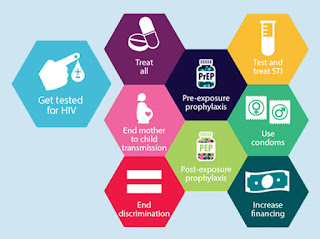AIDS
The term AIDS stands for Acquired Immuno Deficiency Syndrome.
The disease is acquired during life time.
AIDS is caused by human immune deficiency virus (HIV).
HIV is a retrovirus having RNA as the genetic material.
Mode of transmission-
- Sexual contact with infected persons.
- By transfusion of contaminated blood and blood products.
- By sharing infected needles as in the case of intravenous drug abusers.
- From infected mother to her child through placenta.
Life cycle of HIV
- After getting into the body the virus enters into macrophages or T-helper cells.
- The viral RNA genome replicated to form viral DNA with the enzyme called reverse transcriptase.
- The viral DNA gets incorporated into the host cell’s DNA -- directs the infected cells to produce virus particles and the macrophages continue to produce virus.
- Viruses released from macrophages attack T-helper cells and cause a progressive decrease in the number of T helper cells
- Low T cells count -- low immunity-- suffering from infections with several other microorganisms.
- To follow safe blood transfusion.
- To use disposable needles.
- To distribute free condoms.
- To prevent drug abuse
Diagnosed by ELISA (enzyme linked immune-sorbent assay).
Treated with anti-retroviral drugs but that is only partially effective.
Prevention of AIDS-
CANCER
uncontrolled cell division -- formation of a mass of cells called as a tumor.
Contact inhibition is the property of normal cells by virtue of which contact with other cells inhibits their uncontrolled growth.
Cancer cells lost the property of contact inhibition -- cancerous cells continue to divide -- tumor.
Tumors are of two types: benign and malignant.
1. Benign tumors- normally remain confined to their original location and do not spread to other parts of the body.
2. malignant tumors are a mass of proliferating cells called neoplastic or tumor cells.
Malignant tumors grow very rapidly and invade and ultimately damage surrounding tissues.
The property by which cancer cells moves to distant places from their origin by blood and invade the normal cells and make them cancerous is called as metastasis
Causes of cancer-
- Transformation of normal cells into cancerous cells may be induced by physical, chemical or biological agents called as carcinogens
- Physical carcinogens- ionising radiation like X-rays, gamma rays and non- ionising radiation like UV radiation of sun.
- Chemical carcinogens- tobacco smoke and some other chemicals.
- Biological carcinogens-
1. Cancer causing viruses are called oncogenic viruses have genes called viral oncogenes.
2. Cellular oncogenes or proto-oncogenes in normal cells, when get activated lead to oncogenic transformation of normal cells.
Detection of cancer-
- Endoscopy
- Biopsy and histo-pathological study of the tissues.
- Radiography by using X-rays, CT (computed tomography).
- MRI (magnetic resonance imaging).
- Use of antibodies against cancer-specific antigens.
Treatment of cancer-
- Surgery
- Radiation therapy.
- Chemotherapy
- Biological response modifiers- alpha-interferon which activate the immune system and help in destroying the tumor.










No comments:
Post a Comment